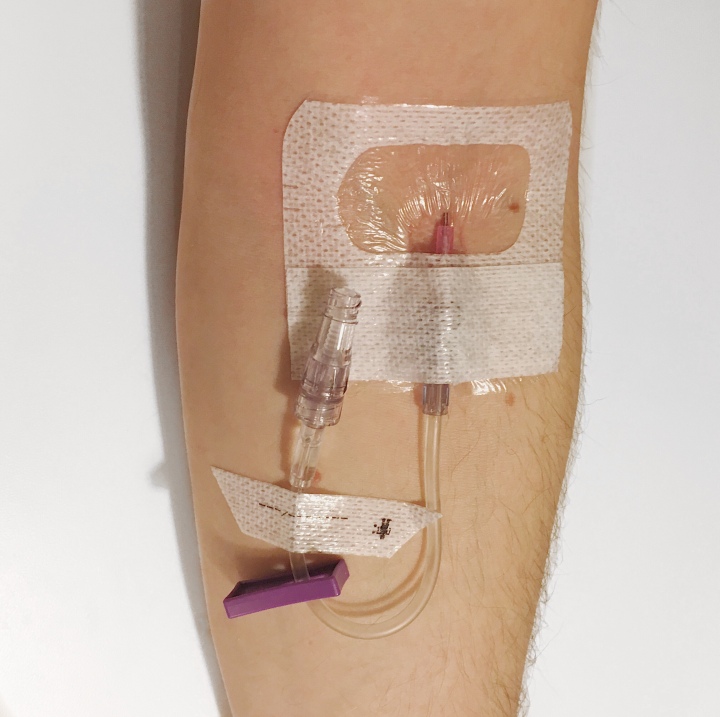
I remember when I was in nursing school heading to my first day of preceptorship in the emergency department nervous that I would botch one of the most common nursing procedures of starting an intravenous line. I was always so worried I would get one of those patients that tells you they are a “hard stick” with “rolling veins”. With some guidance from my fellow nurses, and tricks I learned through being an ER nurse, I am now able to tackle those IV starts with ease. This is my list of tips and tricks to use when starting an IV on those patients who like to warn you that they are an “impossible stick”.
- 2 Tourniquets: This technique is used to help make veins more visible. Place one tourniquet near the upper arm or armpit and the second on the mid upper arm above the antecubital fossa. This is said to increase pressure and help to dilate the vein. One thing to be careful when using this technique is making sure that your veins don’t blow because of the pressure, I find it works best to pop one of the tourniquets once I get blood return.
- Check Everywhere: This might sound like common sense but we so often exclude ourselves from looking anywhere besides the arms. One of my favorite places to go on patients that have extra adipose tissue are the shoulders or chest. For children I often look at feet or ankles and head.
- Ultrasound/Sonosite: Using the US for vein finding helps you to find veins that are not visible to the human eye. This is especially helpful for patients that have edematous conditions or for the patients that have undergone repeated venipuncture already, such as IV drug users or plasma donators. You do have to be trained in US guided IV placement according to your hospitals policies.
- Heat: Applying heat to the skin causes the veins to vasodilate and increases blood flow making it easier for you to feel and see a patient’s veins. I do this by wrapping a warmed blanket around the patients arm or using a heating pack. This also helps if you are doing a capillary draw and the patient has cold hands!
- Poke Deeper/Longer Catheter: This is a technique used on patients that have a little bit of extra adipose tissue. Often times on these patients it is hard to see or feel a vein because of the extra tissue, but you have to remember their anatomy is still the same! The veins are still going to be in the same spot you just have to poke a little deeper and you often need to use an IV that has a longer catheter so that you are able to reach the veins!
- Blood Pressure Cuff: The blood pressure cuff acts similarly to a tourniquet but applies pressure more evenly and over a larger surface area. This is helpful for individuals with very thin skin so that the tourniquet does not cause skin tears or for those individuals who have larger arms and a tourniquet does not apply enough pressure. I do this by putting the BP cuff into stasis mode so it stays inflated for two minutes or until you turn it off when you are finished with your IV start.
- Gravity: Use gravity in your favor when trying to start an IV by hanging the patients arm or appendage off the side of the bed, this encourages blood flow to these areas! This makes the veins easier to see and feel. You can also use this technique on patients that are hypotensive or hypovolemic by placing the patient into trendelenburg position to increase blood flow to the patients neck for external jugular IV placement.
- Catheter Position: Making sure you have proper catheter position and angle is probably one of the most helpful tricks. If the vein is shallower and can be seen on the skin surface your angle should be smaller, if the vein is deeper your angle needs to be larger. Additionally, you must also take into consideration the tissues or structures above the vein that you will be going through such as scar tissue or adipose tissue.
I hope these tricks come in handy the next time you are starting a line! If anyone has any other tips please let me know and comment below!


Using ultrasound for finding a vein is not a practical advise on day to day basis on large number. Know your anatomy well and patiently (where time allows ,) explore with warm ambience. Hurrying and taking pot – shots make things worse with extravasation and tissue damage. Where possible use eutectic patch to minimise discomfort. Good learning and practical experience shall be the day. Do not be shy of changing hands ; (for the sake of patient). The art of phlebotomy and arterial puncture still a neglected subject not given its due merits with consequent morbidity.
DR T BASKARAN , M B B S., DARCP & S., (LON)
Associate Specialist, Anaesthesiology, (RTD) NHS UK
Fellow of Manchester Medical Society ( Eng)
LikeLike
I use to be good at putting i.v’s but i switched jobs and the equipment and i am now having a hard time?? I am use to having the catheter and j loop separate and putting it together now it is all one thing and i have a hard time.
LikeLike
As a veteran ER nurse I would add one thing. If the patient says they’re a hard stick, ask where the most successful area has been in the past. I’ve found that 3 sticks in, a patient will say something like, “they usually get it on the other arm.” Or, my hand seems to be better for an IV. Listening to them can save you both a bit of pain and time. Your list is very good and more new nurses need to be informed of these techniques.
LikeLike
Very helpful
Thanks a lot
LikeLike
Awesome advice! Thanks for posting! I personally LOVE using U/S. But, I find that I sometimes lose my feel and stick skills and become reliant upon the U/S. But, it is an awesome tool to have at my disposal as an ER nurse.
LikeLike
Seems very precise techniques. But can u please with the help of an image or drawing demonstrates the 2 tourniquets techniques? Thanks
LikeLike